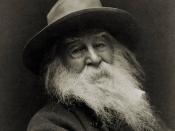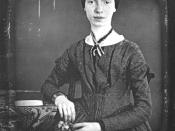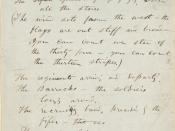Running Head: COMPARISON OF TWO POEMS
COMPARISON OF TWO POEMS
[Writer Name]
[Institute Name]
�
COMPARISON OF TWO POEMS
Introduction
This poem also describes a locomotive train and its features but in short detail. In this poem, the poetess sees the train as a giant worm and wishes to see it passing quickly through the tracks and valleys that it may seem that the train is eating them (Thillmann, 2007). Then train may stop at the fuelling station to "feed" it self and there, the train seems to be a huge mechanical masterpiece with massive force and power. Then she desires that the train may start again, now going through mountains like an arrogant gentleman, showing no attention or care to anyone's comments or critique. Then the train may pass along roadside temporary restrooms, which, as the train moves, fade into the horizon (Thillmann, 2007). Then the train may ride along its tracks, fitting itself into it and like chasing someone and then make sounds like ready tribesmen and at last, as obedient and punctual as a star which shows up on the sky every night, stop slowly at its station like it was never gone anywhere, prepares again to make an exciting journey and please the poetess once again (Thillmann, 2007).
Discussion
Culmination
I like the first poem "TO A LOCOMOTIVE IN WINTER" that is written by "WALT WHITMAN," more than the second poem "I LIKE TO SEE IT LAP THE MILES" that is written by American poet "EMILY DICKINSON." The reason behind this belongs to the description. Both poets described a similar object that is a "train."
Walt Whitman described it in more detailed and organized way, as compared to the description of Emily Dickinson, she only told about the train and the scenery, whereas Walt Whitman described every bit of the object beautifully in an interesting way along with the scenery.
"TO A LOCOMOTIVE IN WINTER" is written in old English that gives the poem a bold and elegant look, whereas "I LIKE TO SEE IT LAP THE MILES" is written in words that do not rhyme in the end, neither do they completely describe the scene. The first one has a wide range of train's features in it along with references to seasons to make it look evergreen, whereas the second one does not make any count for a train's striking features like body work, its organization of parts, its overlook etc. (Thillmann, 2007)
Conclusion
People are exposing themselves to deadly diseases like balance issues, memory loss, lack of concentration which act as a slow poison for them. The death toll of America include a great number of those people whose were taking these medications and their death occurred at young ages of 47 to55 years. The economical and social lives of the people have become so hard and crucial that they cannot stand it anymore, they cannot face it anymore. Nowadays, people hardly get time to look after their selves. They just want to get home from the work. Thus, the poem "TO A LOCOMOTIVE IN WINTER" describes the train more elegantly and leaves an everlasting effect on the reader's mind.
�
Reference
Thillmann, Sandra. (2007). Compare Walt Whitman's 'To a Locomotive in Winter' with Emily Dickinson's 'I like to see it lap the miles.' Published by GRIN Verlag, ISBN3638620298, 9783638620291.


